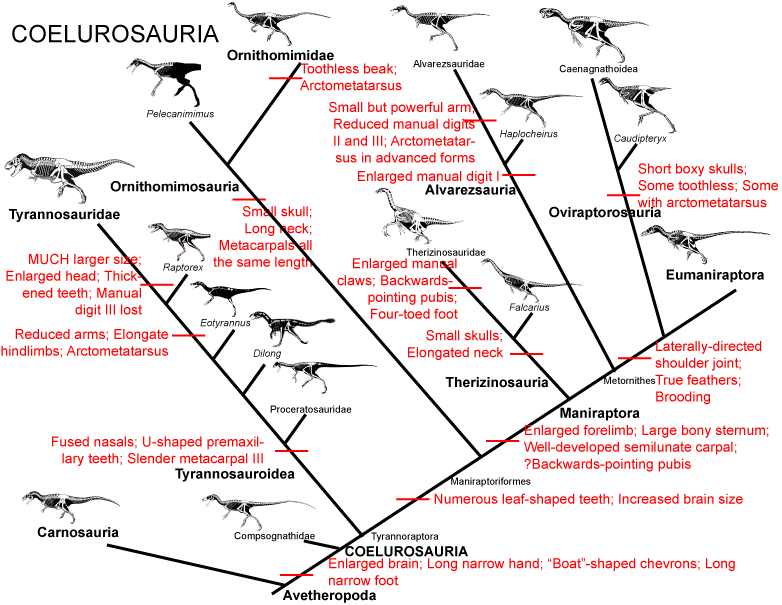|
|
Cladistics |
| Systematics |
Cladistics and Paleontology |
Cladistics: Cladistics and Paleontology
Beginning in the mid 1980s, paleontology began to play an essential role in cladistics, thanks to the pioneering efforts of vertebrate paleontologists like Jacques Gauthier (Gauthier 1986), Eugene Gaffney, Susan Evans, Michael Benton, and others. Significantly, all these scientists were concerned with the evolution of reptiles (and in Gauthier's case and those of others such as Kevin Padian, of birds from dinosaurs); reptiles having a rich fossil record (of course, being cladists, they weren't allowed to use the "R" word in any formal context). In this way, what began as an obscure alternative to phenetics and evolutionary systematics came to be the defining paradigm for understanding the evolution of life (first vertebrate, than the tree of life in general).

Cladistic scenario for the origin of birds from dinosaurs and the consequent evolution of flight. Each successive clade (here moving left to right) includes the attributes of previous ones (parent clades). These sorts of diagrams were used to prove the origin of birds from dinosaurs in the 80s and 90s. After Padian, 1996, via original url - note this author does not agree with dino to bird hypothesis |
Cladistics never really took off with mammals; as mammals are a group with a large number of extant (recent) taxa, a different methodology, molecular phylogeny, was used to determine their evolution. Only in recent years with the unification of molecular sequencing and statistical cladistics has cladistic methodology been applied to mammals. And as for plants, the influence and prestige of Linnaeaus ensures that cladistic formalism will make little inroads for some time.
By the 1990s, synapomorphy-based cladistics had totally replaced evolutionary systematics in the admittedly specialised field of vertebrate paleontology. Many other fields of biological taxonomy, especially botany, have remained staunchly Linnaean (no doubt due to Linnaeus being a botanist and one of the founders of the field). Despite this paradigm revolution, cladistics and evolutionary systematics are two very different systems. One important difference is that evolutionary systematics deals with ancestor-descent relationships, especially in supra-specific taxa, and cladistic trees with sister relationships of individual species, or even, in the case of fossils, individual specimens. Another is that evolutionary systematics is strongly paleontological, emphasising the stratigraphic sequence in the fossil record in deep time, whereas cladistics place a strong emphasis on neontology, as extant taxa can provide far more information - e.g. soft tissue, molecular, etc. Finally, evolutionary systematics emphasises stratigraphic occurrence, whereas at least early cladistic paleontology considers this phylogenetically unimportant (this is changing with current Phylogenetics).
Synapomorphy-based cladistic paleontology and phylogenetic taxonomy were widely adopted by the online paleo community in the late 1990s (see for example the Dinosaur Mailing list archives), and became the central methodology of earlier iterations of Palaeos (the Vertebrate Notes (1999-2001) and Palaeos mk 1 (2002-6)
By the middle of the first decade of the 21st century, the growing power and easy availability of computers meant that single-tree synapomorphy-based cladistics had completely given way to computational cladistics, and easily recognisable synapomorphies were replaced by obscure combinations of character states thrown up by statistical algorithms. In turn computational cladistics, with its emphasis on fossil reptiles, was assimilated by the more widely applied and popular molecular phylogeny to give the new science of phylogenetics and the rejection of morphological parsimony MAK130321

